Authentic Pad Thai made easy! Rice noodles stir-fried in a sweet and tangy sauce, topped with shrimp, sliced tofu, ground roasted peanuts, and fresh bean sprouts.
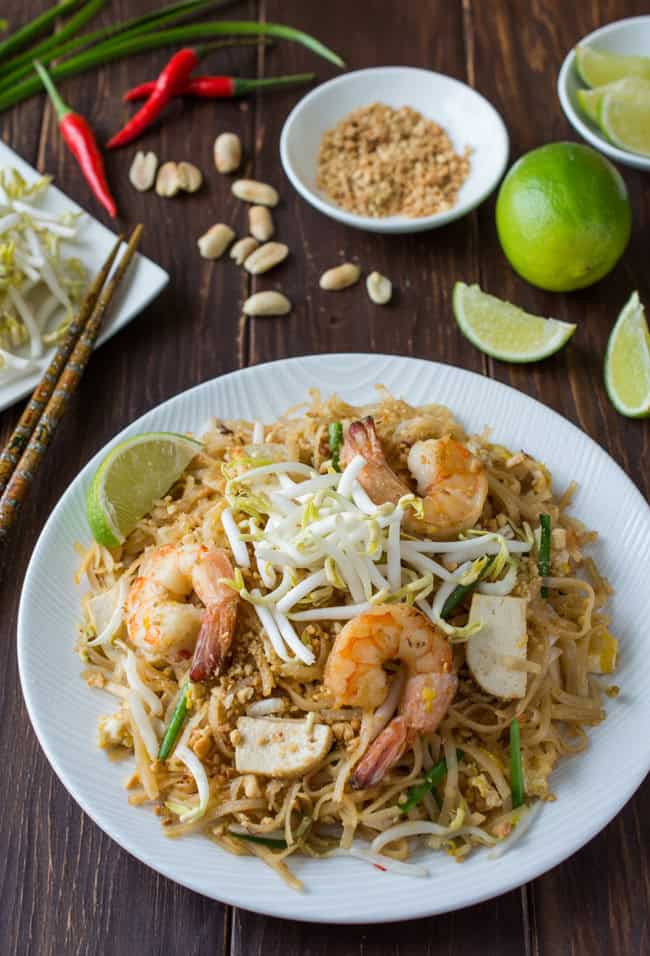
Pad Thai is one of the most popular Thai dishes well-loved all around the world. Rice noodles are stir-fried in a slightly sweet and tangy sauce, then topped with shrimp and sliced tofu. Fresh bean sprouts and ground roasted peanuts are added at the last minute to give the dish a slightly crunchy texture and also fantastic flavor.
There are countless versions of this Thai street food favorite, but the classic version features large succulent shrimp and thinly sliced firm tofu. Chicken and pork are great alternatives.
Tamarind is the star ingredient in the Pad Thai sauce. Tamarind is sold in a few different forms (concentrate, puree, etc) but the type that I normally use is tamarind paste/pulp. You can find it at most Asian supermarkets.
The key to any good stir-fry to have all of your ingredients ready before you fire up the wok:
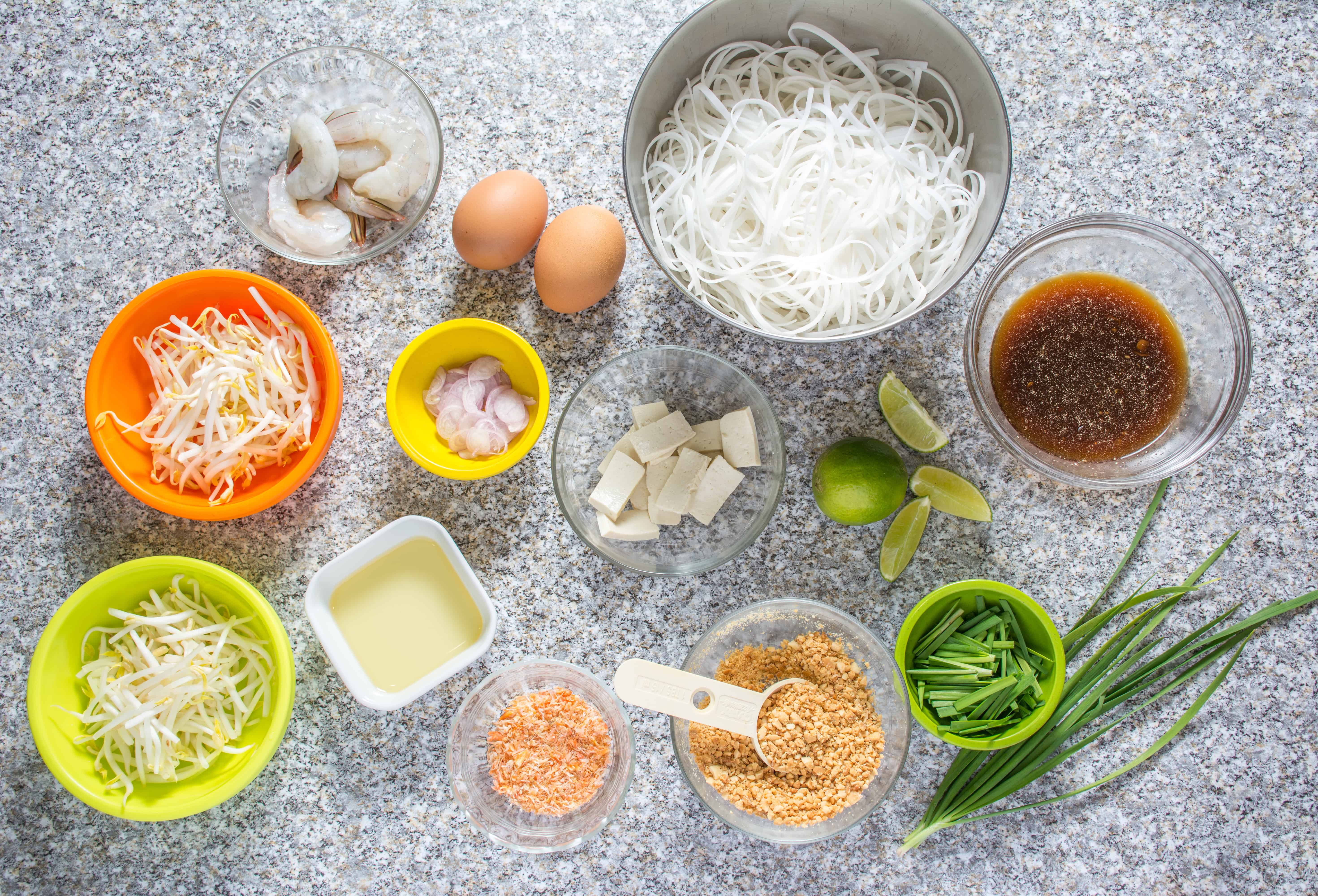
2 cups fresh mung bean sprouts; separated 1 cup in each bowl
6 large shrimp (tail on)
3 tablespoons peanut oil
1 small shallot; thinly sliced
2 eggs (at room temperature)
*2 tablespoons ground dried shrimp (see notes below). Optional but highly recommended.
⅛ cup thinly sliced firm tofu
*¼ cup ground roasted peanuts
150g Pad Thai (dry rice stick) noodles, soaked in slightly warm water for about 20 minutes, then drained
Lime wedges
⅛ cup sliced garlic chives (or scallions)
Pad Thai sauce (see below)
For the dried shrimp and roasted peanuts, I use my Magic Bullet blender to grind them up quickly and easily. You can use any small blender or food processor for this task. For the peanuts, just be sure not to grind them too fine or you will end up with peanut butter!
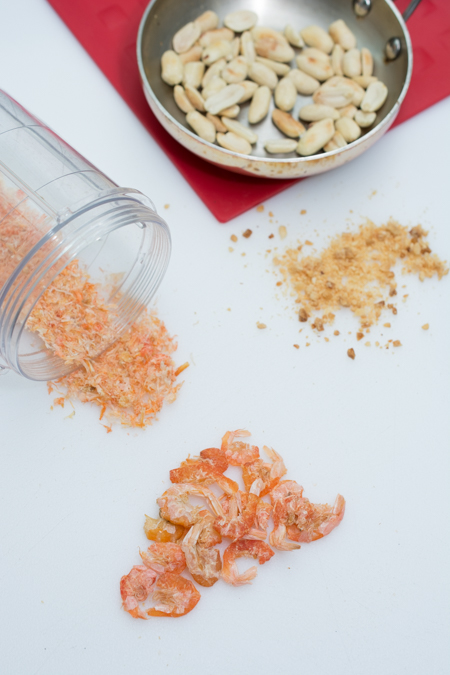
Soaking the Pad Thai Noodles
To prepare the Pad Thai noodles for frying, soak them in slightly warm tap water for 20 minutes. I recommend soaking the noodles just before soaking the tamarind (see below). By the time all of your ingredients are prepared, your noodles will be ready just in time for stir-frying.
After the noodles have soaked for 20 minutes, drain all of the water. If you are running behind on the rest of your food prep, place a wet paper towel over your drained noodles to prevent them from drying out.
Pad Thai Sauce
Soak 1 tablespoon of tamarind paste in about ½ cup of hot water for about 10 minutes. When it has cooled enough to handle, gently press the tamarind pulp with your fingers.
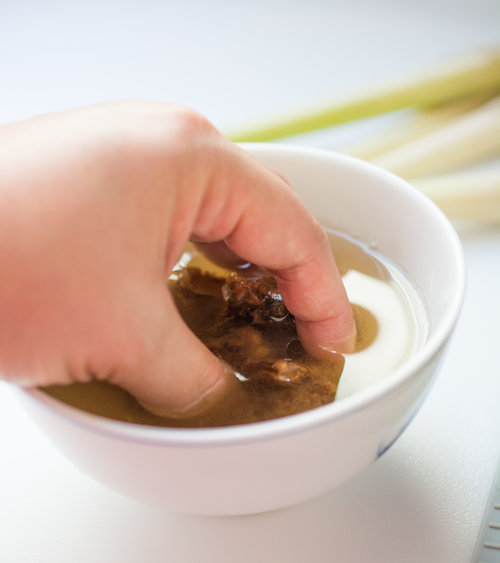
Discard the tamarind pulp, but save about 2 tablespoons of the tamarind water. Add 1 tablespoon Thai sweet chili sauce, 1 tablespoon oyster sauce, 1 tablespoon soy sauce, 2 teaspoons fish sauce, 1 tablespoon brown sugar, and ½ teaspoon chicken stock granules. Stir well to combine all the sauce ingredients.
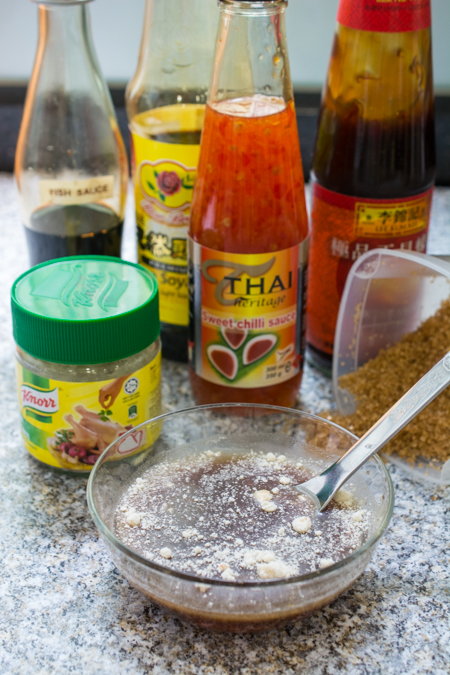
Stir-Frying Pad Thai
Would you like to save this?
Heat about 1 tablespoon of peanut oil in a wok over medium-high heat. Stir-fry the shrimp for 30 seconds, add about ½ a tablespoon of the Pad Thai sauce to the wok, then stir-fry for approximately 30 seconds more or until the shrimp are fully cooked. Remove the shrimp from the wok.
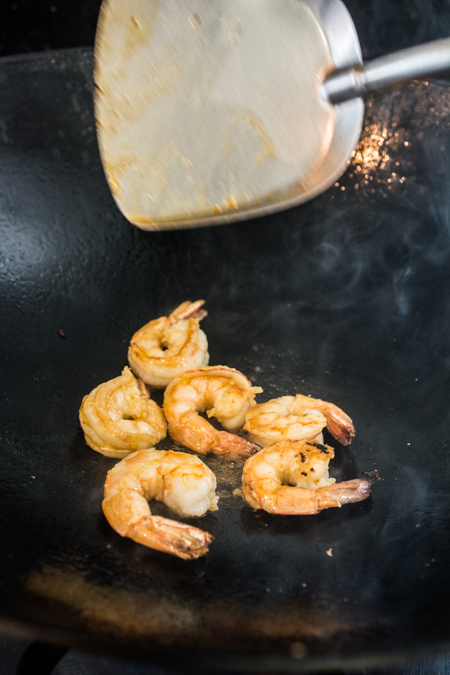
Crack both eggs into the middle of the wok, then add about 1 tablespoon of the Pad Thai sauce on to the eggs. Lightly scramble the eggs with your wok spatula, then remove the eggs from the wok.
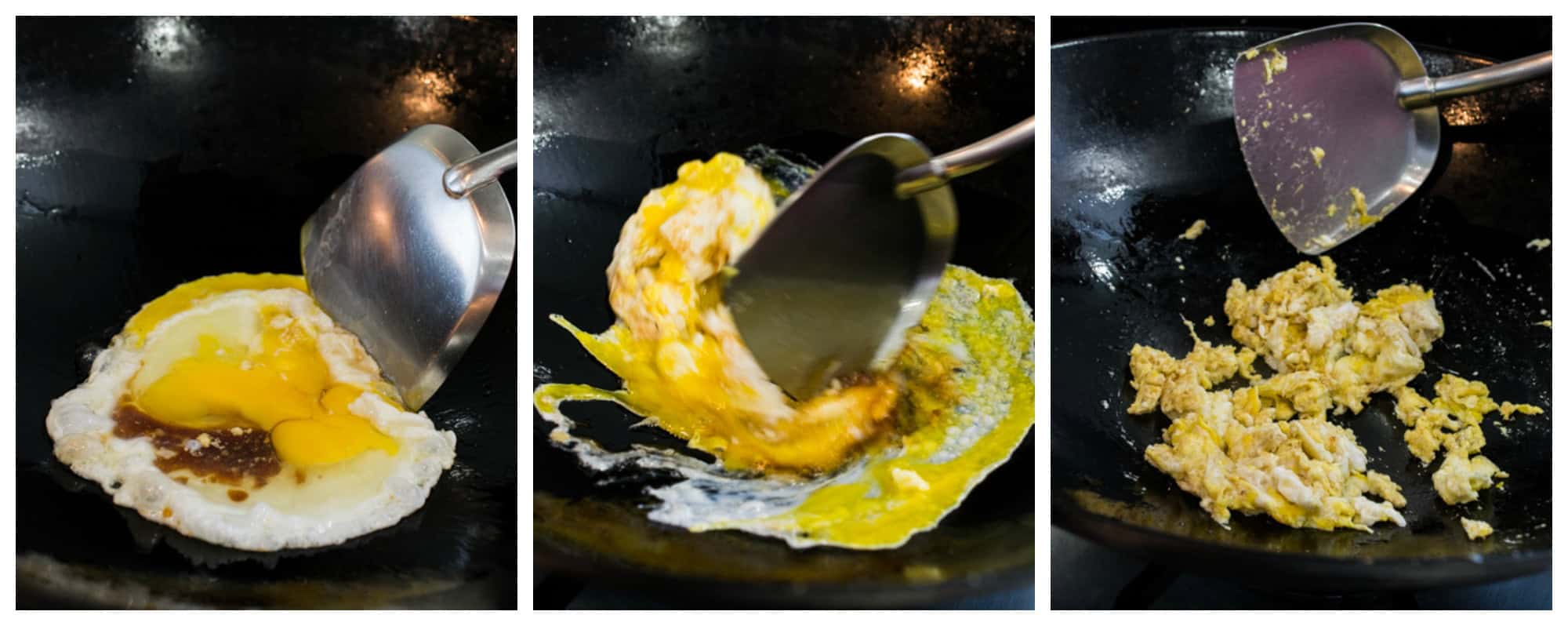
Add 2 tablespoons of peanut oil to the wok, then add the sliced shallot. Gently stir in order to keep the shallot from burning. As soon as you start to see the slightest hint of brown, add the pad thai noodles.
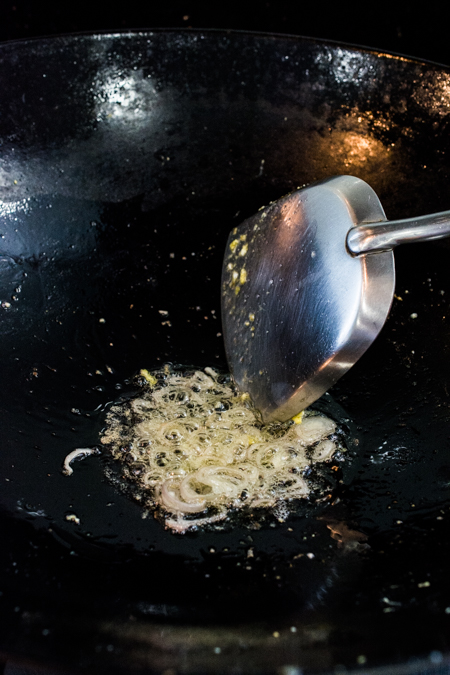
Pour about half of the remaining Pad Thai sauce onto the noodles, You don't want to add all of the sauce right away because how much sauce you really need will depend on how firm the noodles are, how thick they are, etc. If your noodles were already soft and you add all of the sauce, your Pad Thai will be swimming in the sauce. Not good...
After adding half of the sauce, stir-fry the noodles to coat the noodles in the sauce. Then, do a quick taste test. If the noodles are still bland and/or if the noodles are still too firm, add more sauce at little bit at a time until you get perfect Pad Thai noodles.
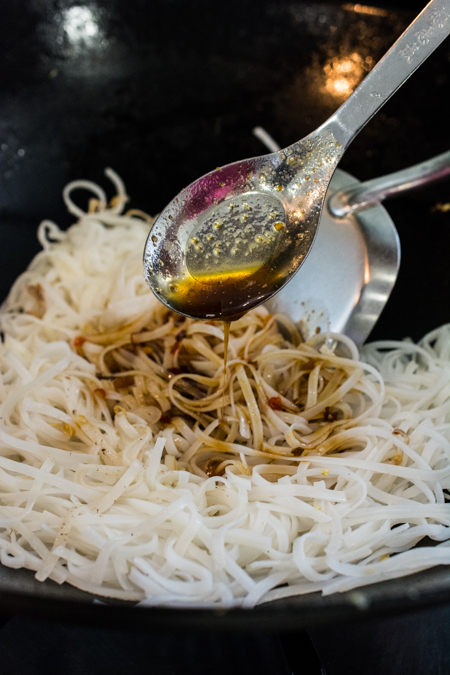
Return the cooked shrimp and eggs to the wok, then add 1 cup of the fresh bean sprouts, sliced tofu, garlic chives, ground dried shrimp (optional) and half of the ground peanuts.
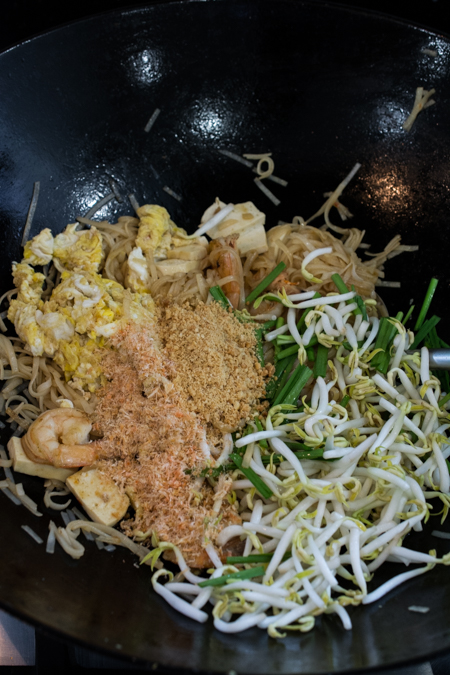
Give the noodles a few more tosses to mix all of the ingredients well.
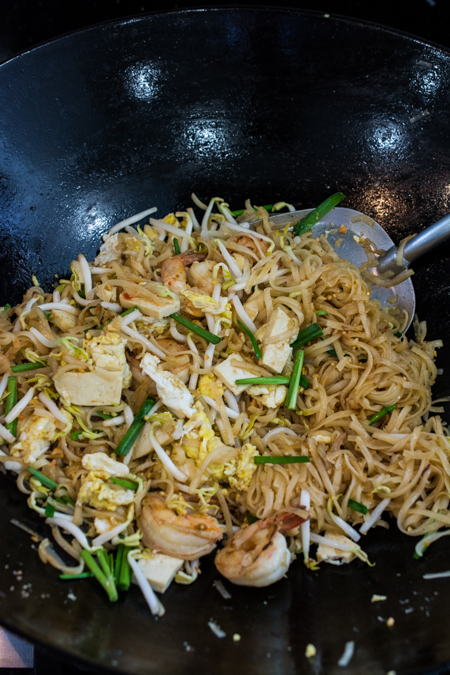
Transfer the Pad Thai to a serving dish. Serve with the remaining fresh bean sprouts and ground peanuts, and lime wedges. If you like your Pad Thai spicy, you may also add some thinly sliced Thai bird chili or crushed red pepper.
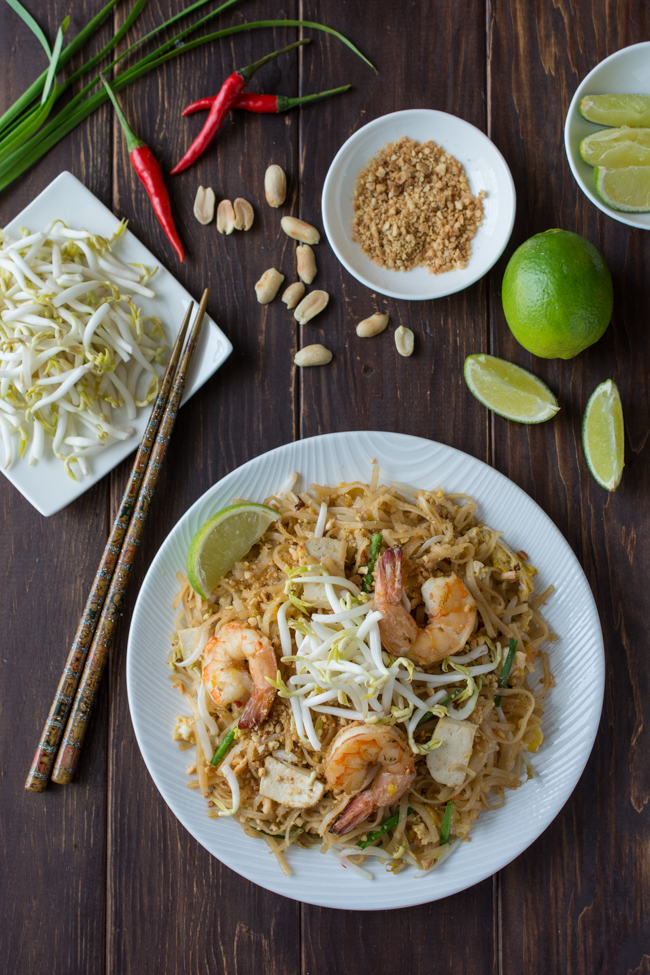
Enjoy!

Pad Thai
Ingredients
- 150 g dry Pad Thai rice stick noodles rice stick noodles
- 3 tablespoons peanut oil
- 6 large shrimp peeled, deveined, tail on
- 2 eggs room temperature
- 1 small shallot thinly sliced
- ⅛ cup thinly sliced firm tofu
- 2 cups fresh bean sprouts
- ⅛ cup sliced garlic chives 1-inch pieces
- ¼ cup ground roasted peanuts
- 2 tablespoons small dried shrimp ground (optional)
- 1 lime cut into wedges
For the Pad Thai sauce:
- 1 tablespoon tamarind paste
- ½ cup hot water
- 1 tablespoon Thai sweet chili sauce
- 1 tablespoon oyster sauce
- 1 tablespoon soy sauce
- 2 teaspoons fish sauce
- 1 tablespoon brown sugar
- ½ teaspoon chicken stock granules
Instructions
- Soak the Pad Thai noodles in slightly warm tap water for 20 minutes.
While waiting for the Pad Thai noodles to soften, prepare the Pad Thai sauce:
- Soak tamarind paste in hot water for 10 minutes. When the water has cooled enough to handle, gently press the tamarind pulp with your fingers.
- Discard the pulp, saving about 2 tablespoons of the tamarind water. Add Thai sweet chili sauce, oyster sauce, soy sauce, fish sauce, brown sugar, and chicken stock granules. Mix well.
- Drain the Pad Thai noodles.
- Heat 1 tablespoon of the peanut oil in a wok over medium-high heat. Stir-fry the shrimp for 30 seconds, add ½ tablespoon of the Pad Thai sauce, then fry for the shrimp for 30 more seconds or until the shrimp are fully cooked. Remove from the wok and set aside.
- Crack the eggs into the wok, then add about 1 tablespoon of the Pad Thai sauce to the eggs. Lightly scramble the eggs with your wok spatula. Remove form the wok and set aside.
- Add the remaining peanut oil into the wok, then add the sliced shallot. Stir gently until the shallot turns slightly brown.
- Add the Pad Thai noodles to the wok.
- Stir in half of the remaining Pad Thai sauce, then toss the noodles to coat them in the sauce. Do a quick taste test. Add more sauce a little bit at a time as needed until the noodles are at the right consistency and flavor.
- Return the cooked shrimp and eggs to the wok. Add 1 cup of the bean sprouts, sliced tofu, garlic chives, ground dried shrimp (if using), and ⅛ cup ground peanuts.
- Transfer to serving plates. Serve with the remaining fresh bean sprouts and ground peanuts, and lime wedges.
- Enjoy!
Nutrition


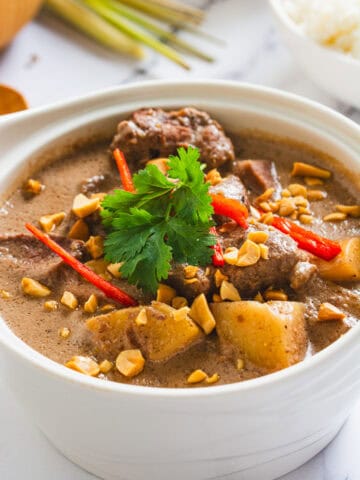
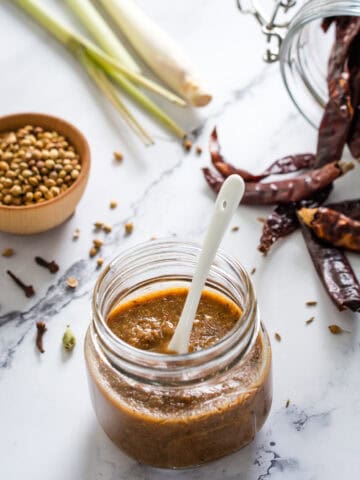
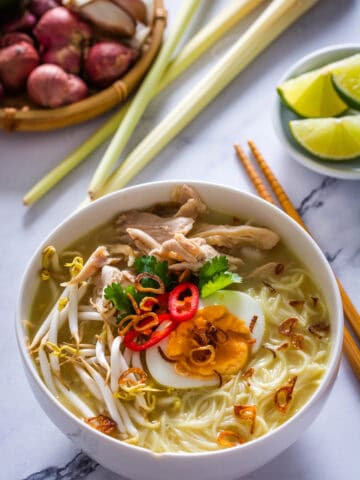
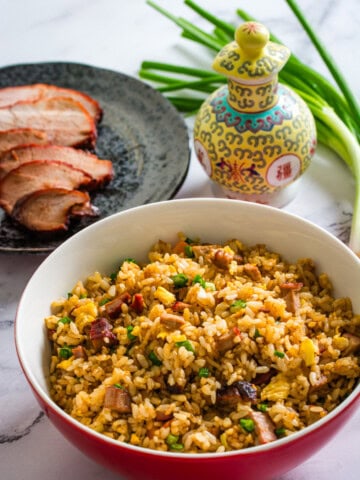
Michelle Miller says
This is so beautiful Char-- I love Thai. I actually have never had pad Thai because I'm allergic to tamarind-- what could I sub for that?
Char says
Thanks, Michelle! There are several alternatives for tamarind substitutes. I would recommend trying tomato ketchup or apricot jam, mixed with rice vinegar (equal parts) with a touch of brown sugar. Hope that helps! 🙂
Trisha says
Char, this looks fantastic. So happy to finally find an authentic Pad Thai recipe thats made from scratch. I can't wait to try this.
Char says
Hi Trisha, Thanks so much for checking out this recipe! Would love to hear your feedback once you give it a try. Have a great day! 🙂